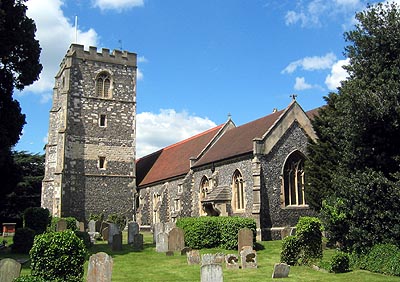 |
||
|
|
 Bray BraySt. Michael's Church The present parish church at Bray was built to replace a previous Saxon building around 1294. The old church is said to have stood some way outside the main village at Water Oakley. The villagers weren't best pleased by the long walk and tore it down. Everyone had to contribute to the rebuilding, but some were reluctant to pay up and the beadle had to be sent in to sort the situation out. A more romantic tale tells of demons destroying the old church in at the dead of night! Today only a few odd carvings brought from the old building remain: A dog (or a horse?) is built into the outer wall of the Chantry Chapel of Our Lady in the churchyard and an unusual 'Sheela-Na-Gig' sits high up between the church's rafters. This latter is a pre-Christian fertility symbol, often found in Ireland, showing a female figure proudly displaying her nether regions. It was meant to remind the faithful of the sinful pagan rights from which they had escaped. The church was, of course, originally constructed in the Early English style, but it was given many perpendicular additions and alterations in the early 14th century - including the fine tower. It is a surprisingly large building for a small village, but this reflects the size of the parish which covers many manors and associated hamlets scattered throughout Windsor Forest. The lords of these manors made great patrons and this can be seen in the many monuments and memorial chapels throughout the church. The Foxley Chapel (of All Saints) stood at the east end of the South Aisle and it was from here that the superb superb brass to Sir John Foxley and his two wives came (1378) . John lived at the moated manor house at nearby Foxley Green (Touchen End), but also held a small castle at Bramshill just over the Hampshire border. His first wife (with the heraldic lion decorating her dress) was the daughter of Sir John and sister of Sir Bernard Brocas of Clewer, the great friend of the Black Prince. His second wife was apparently of low birth as she has only her husband's arms on her dress. Several generations of the family were Constables of Windsor Castle, including their son and Sir John's father. Both were called Thomas and had their own brasses in the church, which have, sadly, disappeared. Although the indent of the later one (1436) survives in the porch and the inscription was recorded a couple of centuries ago. The opposing chapel in the North Aisle was the Norreys Chapel (of St. Nicholas). Interestingly, it was adopted by both local branches of the Norreys family who thought they were closely related - but weren't. Sir John Norreys directed in his will (1466) that he should be buried in a marble tomb tomb here, though this no longer exists. Quite a celebrity at Court, when not in London attending King Henry VI (or Edward IV depending who was in power), he lived at the magnificent Ockwells Manor at Cox Green. Most of the other Norreys interred here, came from Fifield Manor, elsewhere in the parish. Most notable is the black marble wall monument to Sir William Norreys KG. Like the chapel in the churchyard, these were both chantry chapels kept up by family bequests which paid for a private priest to pray for the souls of the dead. From 1448, one of them lived in the little cottage built over the lychgate; but the practice was abolished during the Reformation. Other fascinating memorials, include a local fifteenth century Justice of the King's Bench, William Laken, in brass and the beautiful demi-figures of William Goddard and his wife. In 1609, the latter founded the Jesus Hospital in the village, where another figure of him may be seen. But underneath the central portion of the nave is said to be buried Bray's most famous resident, Simon Alleyn, the so-called 'Singing-Vicar'. This famous Vicar of Bray had a well-known ballad written about him in which he promised to stick to his principles: no matter what religious denomination he had to adopt, he would always remain, 'the Vicar of Bray, Sir'. The poem itself suggests a man living through the troubled years of the late 17th century, but the story is known to be much older and probably refers to the even more turbulent times of the Reformation. Hence Alleyn, who was vicar from 1523 to 1565, is thought to be the man in question. |
|
| © Nash Ford Publishing 2003. All Rights Reserved. | ||
